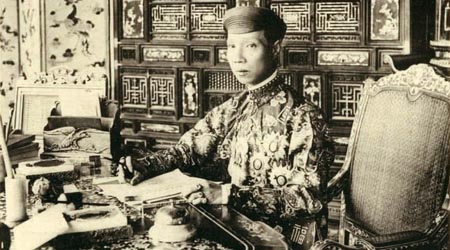In each era clothing reflects cultural values. During the feudal period in Vietnam, the style of royal clothes, especially in Nguyen dynasty show the culture of clothing at that time. It is also the picture which clearly depicts a traditional industry of Vietnam – weaving.

Colour
When it comes to royal clothing, it refers to the clothes of the King, the Queen and the whole royal family. The King and the Queen mother wore dark yellow clothes. The Queen and Crown prince wore orange. The Crown prince also wore purple clothes, as did the Titled Prince and older Princess (sister of the King). And the titled junior prince and princess in red. The imperial concubines wore red, orange or violet clothes depending on their hierarchy. The chasubles in the heaven – worshipping ceremony and clothes of horsemen are jet black.
Patterns
Most royal clothes were embroidered with different patterns. These patterns carried symbolic meanings or were merely just for decoration.
Dragon: symbolizes the power of the King. Dragon pattern can be full body, a dragon –like cloud or nine dragons.
Unicorn: This mythical animal symbolizes the respect of mandarin toward the King.
Phoenix: symbolizes wealth and prosperity. It was often associated with women.
Turtle: the symbol of immortality and stability.
Eight weapons: they were ornaments with different meanings, such as wealth, happiness and health.
The King would wear variety of clothes depending on the ceremony, ritual or duties he performed. The wardrobe of the King and Queen were usually decorated with such patterns as an embroidered dragon, phoenix or eight weapons.
Materials
The robes of the king and the Queen were made of an array of materials like satin, yellow satin, red satin and brocade, which is a rare type of precious silk. During the Nguyen Dynasty (1802 – 1945), there were many developed industries related to embroidering throughout Vietnam.
Silk Weaving in Gia Dinh, Dinh tuong, An Giang, Khanh Hoa.
Satin Weaving in La Khe – Tu Liem, Hanoi.
Thin thread satin weaving in many villages in Thanh Hoa and Ha Tay.
In terms of fine arts, the royal clothes of the Nguyen dynasty are also displayed in masterful works of art. It is the combination of tailoring, embroidering and painting in accordance with the decorative style which denote the unique characteristics of the Nguyen dynasty. These models appeared in many materials in Hue dynasties such as wood, fabric, copper, lime, pottery and porcelain. The history of the Nguyen dynasty not only lies with the precious clothes and valuable objects, but also the masterpieces of art and unwritten archives which are essential for the study of cultural of the Nguyen Dynasty in Hue.